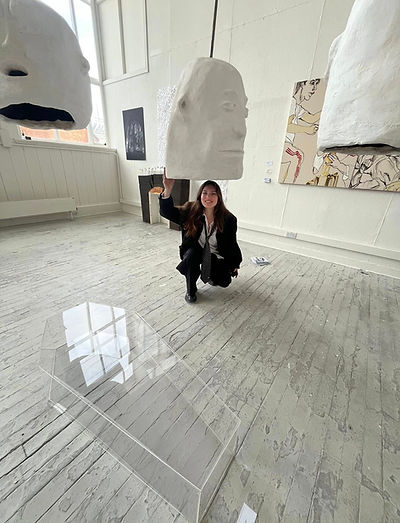Special Interest
Every year at EAF, we provide a 'Special Interest' platform for artists and designers who have something unique to offer. The work that these people bring is not always for sale, but we believe that they warrant the publicity that the fair can bring them, and we love what they can bring to the fair.
This year, we are introducing two exciting 2025 graduates from
Edinburgh College of Art.
Elena Gadd
Media: Sculpture (and visitor interaction)
"The Funeral"
I see masks as vessels of truth. I use this visual connotation to direct viewers into perceiving my critique in pieces like The Funeral.
The piece is an investigation into norms, exploring how differently we all process tragedy and the distinctions between various cultures' ways of expressing grief. It can act as a surrogate for viewers to project their own feelings of loss.
It questions the self-conscious nature of our handling of interpersonal relations and the ridiculousness of navigating it all. Since the interactions between viewers and artworks are plays, viewers are actors wearing the mask of a character.
A mask is worn in ceremonial contexts in many countries (theatre, rituals, funerals, coronations) in which one’s most individual characteristics need concealment. Its presence demands a change in attitude. It conceals expression by displaying another fixed one, which allows free expression.
Masks also highlight or represent a specific aspect of our nature by acting as caricatures of certain aspects of ourselves. They are archetypes with which we are familiar and use to understand the world around us. In this way, the heads and the notice boards are both specific and universal. Sincerity is mixed with farce.
The emotions in each head contrast with the emotions displayed on the faces, giving them a three-dimensional personality and highlighting what social appearances conceal.

Hattie Quigley
Media: Oil Painting
“Girls Gone Gluttonous”
Hattie Quigley is a visual artist whose practice consists of oil paintings and sculpture. Exploring the relationship between femininity, food and female desire, her work poses the question of what it means to be a hungry woman in contemporary society. Revelling in the deliciousness of being ‘too much’, she explores gluttony, excess and indulgence. She immerses the viewer in the visceral pleasure of her painted world, one where women gorge and feast, lose inhibition, and reject the notion that physical attractiveness should be a baseline before you can start to live.
The buttery, deliciousness of paint, flesh and food are bound together in emotional, pulsing marks that dance around the histories and language of painting. Drawing inspiration from everything from mythical feasts and the Baroque period to pop culture and binge drinking, a hedonistic bacchanal unfolds within the paint. Through a lens of overstimulation and excess, she explores women’s individual experience and the political and social meanings of body, of food, of thinness today. In the current climate of right-wing conservatism and weight loss jabs, it is even more political to talk about women who are unashamedly insatiable.
The works celebrate bodies in all their forms while examining the tension between extravagance and restraint that we all adhere to be accepted by society. Not only does food speak of erotic desire, power, obsession, and fear, but it also deals with capitalism and consumerism; the gluttony of the world, dancing around what painting is in its very essence.



